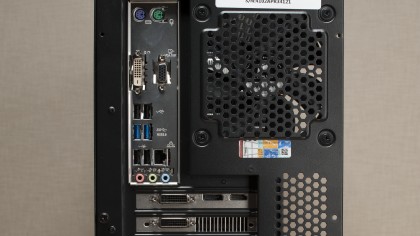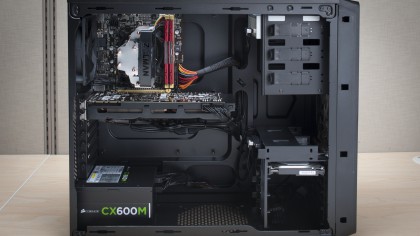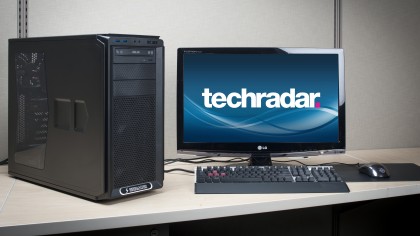Why you can trust TechRadar
The Vanquish II "Ultimate" configuration is at an interesting tipping point. The internals are far punchier than the average gaming laptop, but won't deftly outperform other top-tier gaming PCs. That's not to say Digital Storm can't make a great high-end gaming machine – just look at the Bolt II – but the Vanquish definitely feels middle of the pack.
That said, when compared side-by-side to its spec sheet, this Vanquish II establishes a solid baseline of price for power. Here's the Digital Storm Vanquish II configuration sent to TechRadar in detail:
Spec sheet
- CPU: 3.2GHz Intel Core i5-4570 (quad-core, 6MB cache, up to 3.6GHz with Turbo Boost)
- Motherboard: Asus H81M (Intel H81 Chipset)
- Graphics: PNY Nvidia GeForce GTX 770 (2GB GDDR5 RAM)
- Memory: 8GB DDR3 (1600MHz)
- Storage: 120GB Samsung 840 EVO SSD; 1TB Seagate HDD (7,200 rpm, 64MB cache)
- Optical drive: DVD‐R/RW/CD‐R/RW (DVD Writer 24x / CD‐Writer 48x)
- Operating system: Microsoft Windows 8.1 (64‐Bit Edition)
- Power supply: 600W Corsair CX
- Ports: 3.5mm headphone/mic jack, 2 USB 3.0 ports (front); PS/2 input ports, VGA, 4 USB 2.0, 2 USB 3.0, Ethernet, 3.5mm headphone/mic, HDMI, 3 DVI (rear)
- Weight: 15 pounds
- Size: 21.65 x 8.27 x 17.32 inches (W x D x H)
Costing a cool $1,259 (about £747, AU$1,365), the Level 4 version of the Vanquish II may not sound cheap at face value. However, you can take some solace knowing you're paying for premium parts (save for that motherboard), and that extra cost will pay for itself when it comes time to upgrade.

If you're in the market for a less powerful machine, check out the Level 1, 2, and 3 machines. There's a lot of wiggle room to save $600 (the Vanquish II starts at a surprisingly low $699) here. But in doing so, you trade the Core i5-4570 for an i3-4330 and that GTX 770 for its little brother, the GTX 750. You'll also lose out on the solid-state drive and swap a 1TB hard drive out for a 500GB model.
Performance
These components worked together to produce some relatively formidable numbers in our synthetic tests. Bioshock's opening scene dazzled as it spit out an ultra-smooth 83 frames per second on the highest possible settings. Metro Last Light, on the other hand, grinded to a near-stop when gunfire filled the screen. Here are the benchmark scores in detail below:
Benchmarks
- 3DMark: Ice Storm: 147,971; Cloud Gate: 16,207; Fire Strike: 6,615
- Cinebench Graphics: 59.11 fps; CPU: 5.67 points
- PCMark 8 (Home): 3,783 points
- Bioshock Infinite (1080p, Ultra): 83.90 fps; (1080p, Low): 220.75 fps
- Metro: Last Light (1080p, Ultra): 32.67 fps; (1080p, Low): 90.33 fps
These numbers may seem obfuscated, but the short of it is that the high PCMark 8 score means fast web browsing and quicker load times in your favorite programs. Meanwhile, high frame rates in last year's hottest games means you'll be able to ride the GTX 770 for a while to come.
No muss, no fuss
There's no single term to describe a PC gamer. Some can hardwire circles around others, while some are simply content with a super-fast system that works – no assembly required. Obviously, a boutique build, like the Vanquish II, appeals more to the the latter. It's an incredibly clean machine that, despite my own experience, would be tough to replicate.

It's refreshing to buy a machine – OS already installed – ready to download Steam the moment it arrives at your door. Overall, the device was painless to set up and use, something I can't say about every PC I've ever built, used or tested. Plus, the chassis is easy to get into and close, thanks to a single thumbscrew on the back panel.
The Vanquish II doesn't win any awards for silence: the machine runs at a noticeable, near-whisper pitch. Nor does the unit take home the award for the lightest desktop, either. If you're looking for that, though, you're in the wrong place. This feels like a desktop built by gamers for gamers, and doesn't necessarily include the rest of the PC user base in its agenda.
Boring board
One of the most glaring weaknesses of this machine is its micro-ATX, Asus H81M motherboard. It's eloquent, succinct and thoughtful, sure, but those are all nice ways of saying there's just no room to expand on this board.
The GPU takes up the single PCIe x16 slot, leaving only a single PCIe slot free. Have both a sound card and wireless expansion card? You're out of luck. This board just can't support any rear-port expansions.

While this is more of a complaint of aesthetics than functionality, parts are exceptionally close on the board. This might send design-conscious minimalists' hearts aflutter, but makes certain parts, like the CPU, tough to access without removing the bulky GPU.
Roll with the support class
You're reading TechRadar, so you're likely savvy tech user. Value-added propositions like technical support and a 4-year warranty may not mean a whole lot to you. Still, you'll be left wanting for services like these when you least expect it.
Think about those times when you can't figure out something difficult, like how to change that one BIOS setting, or need something simple, like an upgrade question answered. Extensive warranties are ideal for high school graduate gamers with a wad of graduation cash, buying a machine for college.
Offerings like these may not be the deciding factor between building a PC yourself or buying a pre-built machine. But warranties and support guarantees are undeniably strong perks for choosing the latter.
Nick Pino is Managing Editor, TV and AV for TechRadar's sister site, Tom's Guide. Previously, he was the Senior Editor of Home Entertainment at TechRadar, covering TVs, headphones, speakers, video games, VR and streaming devices. He's also written for GamesRadar+, Official Xbox Magazine, PC Gamer and other outlets over the last decade, and he has a degree in computer science he's not using if anyone wants it.

